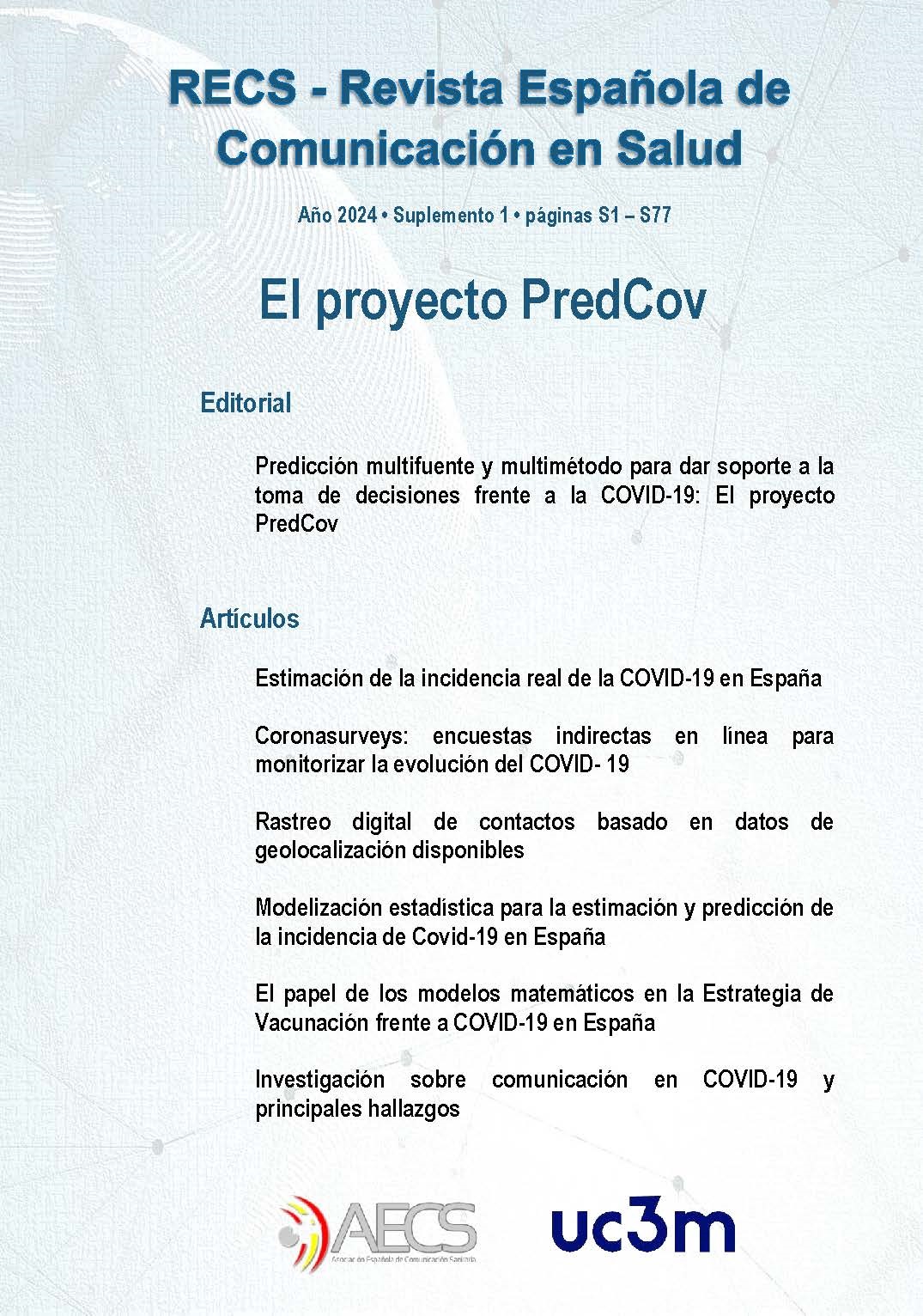Coronasurveys: indirect online surveys to monitor the evolution of COVID-19
Abstract
Introduction: Monitoring the evolution of COVID-19 has been essential for health decision-making. But this requires reliable numbers of the infected, dead and hospitalized, often difficult to have for multiple reasons. The use of fast and reliable estimation techniques, such as indirect surveys, is an option. Objectives: To present the CoronaSurveys project, which monitors COVID-19 by combining indirect surveys with the Network Scale-up Method (NSUM). Methodology: The system uses indirect online anonymous surveys to inquire about COVID-19, and the NSUM method to estimate cases. The system offers multi-language surveys with questions to track active cases, new cases, and fatalities, among others. Results: CoronaSurveys has been operating since March 2020, and continues to collect data, with over one hundred responses to date (over one million samples). The system has made good estimates for Spain and the United Kingdom, among other countries. Conclusion: This system is suitable in countries with limited health infrastructure or in situations of lack of knowledge about the pandemic, such as at the beginning of COVID-19, because its implementation cost is small and it requires simple devices to use it and few participants to obtain good estimates.
Downloads
References
Baquero, C., Casari, P., Fernandez Anta, A., García-García, A., Frey, D., Garcia-Agundez, A., … Sanchez, I. (2021) The CoronaSurveys System for COVID-19 Incidence Data Collection and Processing, Frontiers in Computer Science., http://dx.doi.org/10.3389/fcomp.2021.641237
Bernard, H. R., Hallett, T., Iovita, A., Johnsen, E. C., Lyerla, R., McCarty, C., et al. (2010). Counting Hard-To-Count Populations: the Network Scale-Up Method for Public Health. Sex. Transm. infections 86 (Suppl. 2), ii11–ii15. http://dx.doi.org/10.1136/sti.2010.044446
Dunbar, R. (1992). Neocortex size as a constraint on group size in primates. J. Hum. Evol. 22, 469–493, https://doi.org/10.1016/2560047-2484(92)90081-J
Facebook Data for Good. COVID-19 symptom survey {request for data access. https://dataforgood.fb.com/docs/covid-19-symptom-survey-request-for-data-access/ Accessed: 2020-05-20.
García-Agundez A., Ojo O., Hernandez H., Baquero C., Frey D., Georgiou C., … Fernandez Anta A. (2021). Estimating the COVID-19 Prevalence in Spain with Indirect Reporting via Open Surveys. Frontiers in Public Health, 9. http://dx.doi.org/10.3389/fpubh.2021.658544
Laga I, Bao L., & Niu X. (2021) Thirty Years of The Network Scale-up Method, Journal of the American Statistical Association, 116(535), 1548-1559, http://dx.doi.org/10.1080/01621459.2021.1935267
Maxmen, A. (2020). How Much Is Coronavirus Spreading under the Radar?. Nature 10. http://dx.doi.org/10.1038/d41586-020-00760-8 Available at: https://www.nature.com/articles/d41586-020-00760-8
Nishiura N., Klinkenberg D., Roberts, M., & Heesterbeek, J. (2009) Early epidemiological assessment of the virulence of emerging infectious diseases: a case study of an inuenza pandemic. PLoS One, 4(8), 2009. https://journals.plos.org/plosone/article?id=10.1371/journal.pone.0006852
Ojo O., García-Agundez A., Girault B., Hernandez H., Cabana E. Garcia, A., … Fernandez A. (2020). CoronaSurveys: Using Surveys with Indirect Reporting to Estimate the Incidence and Evolution of Epidemics, arXiv:2005.12783 v2 Presented in KDD Workshop on Humanitarian Mapping, San Diego, California USA, August 24, 2020
Oliver N., Barber X., & Roomp, K. (2020). The covid19 impact survey: Assessing the pulse of the COVID-19 pandemic in Spain via 24 questions. CoRR, abs/2004.01014.
Pollán, M., Pérez-Gómez B., Pastor-Barriuso, R., Oteo, J., Hernán, M.A., Pérez- Olmeda, M., et al. (2020) Prevalence of SARS-CoV-2 in Spain (ENE-COVID): a nationwide, population-based seroepidemiological study. Lancet. 396, 535–44. http://dx.doi.org/10.1016/S0140-6736(20)31483-5
Ruppert, E., Grommé, F., Upsec-Spilda, F., & Cakici, B., (2018). Citizen Data and Trust in Official Statistics. Economie Statistique/Economics Stat. (505-506), 171–184. http://dx.doi.org/10.24187/ecostat.2018.505d.1971
The CoronaSurveys research team. (2020). CoronaSurveys: Monitoring the incidence of COVID-19 via open surveys. https://coronasurveys.org/. Accessed: 2020-05-20.
Ramírez, J., Diaz Aranda, S., Aguilar, J., Ojo, O., Lillo, R., & Fernández Anta, A. (2023). A Snapshot of COVID-19 Incidence, Hospitalizations, and Mortality from Indirect Survey Data in China in January 2023. medRxiv 2023.02.22.23286167 Presented in the 6th International workshop on Epidemiology meets Data Mining and Knowledge discovery. Long Beach, California, USA, August, 2023.
All articles published in this journal –unless otherwise stated- are distributed under the terms of the Creative Commons Attribution-NoDerives (CC-BY-ND 3.0 ES) Spain 3.0 License, which allows others to copy, distribute and transmit in a public way as long as they credit the author(s), journal and institution that publish these articles, and provided that they are not altered or modified. The complete license can be consulted in: https://creativecommons.org/licenses/by/3.0/es/deed/.es
The copyright belongs to the manuscript’s author just on the basis of creating this work:
- Moral rights are undeniable and inalienable.
- Economic or exploitation rights can be transferred to third parties, as it occurs when articles are published and authors partially or totally transfer their exploitation rights to publishers
Authors can archive their own articles in an institutional repository as long as their publications are cited in this journal.
Funding data
-
Comunidad de Madrid
Grant numbers COMODIN-CM -
Comunidad de Madrid
Grant numbers PredCov-CM -
European Regional Development Fund
Grant numbers TED2021-131264B-I00;PID2019-104901RB-I00




